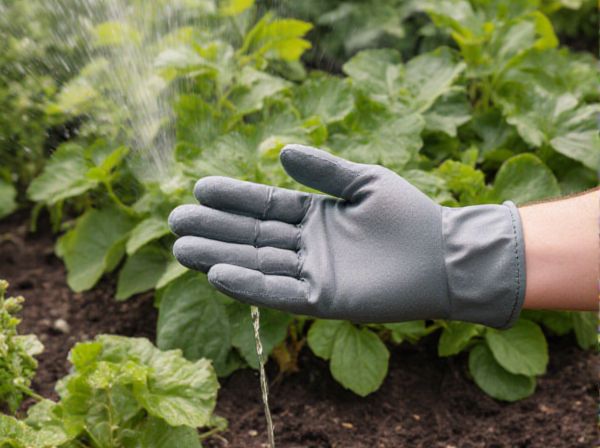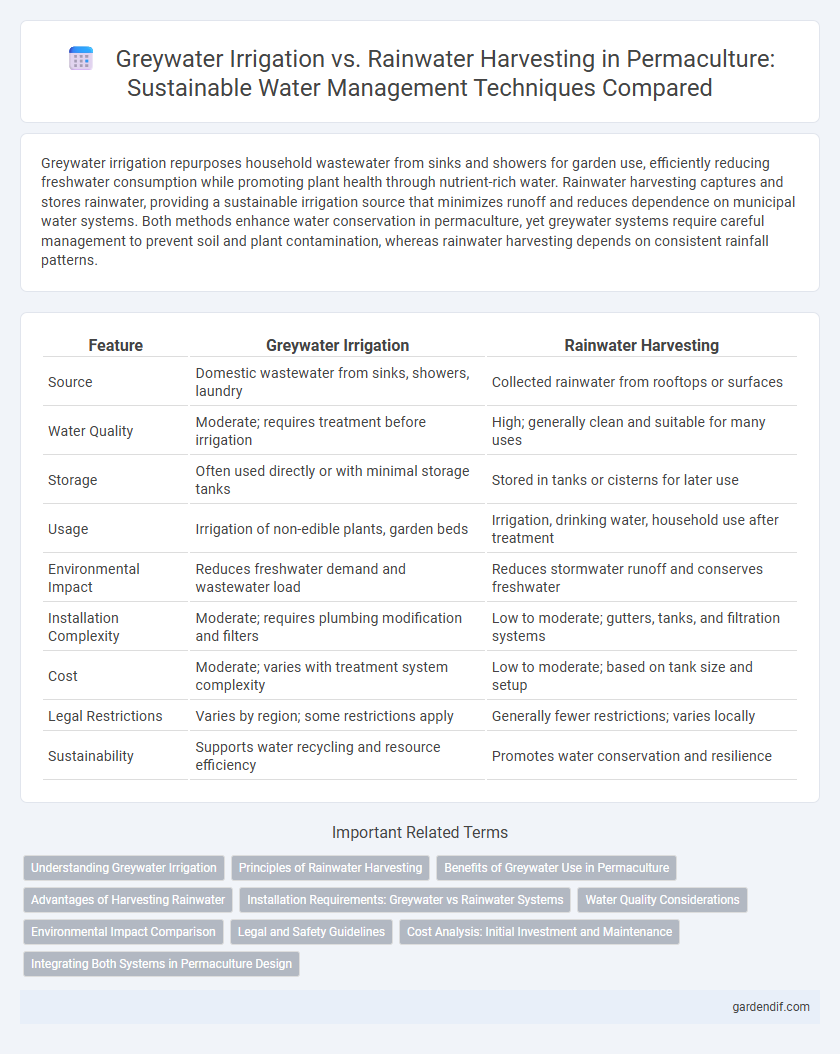
Greywater Irrigation vs Rainwater Harvesting Illustration
Greywater irrigation repurposes household wastewater from sinks and showers for garden use, efficiently reducing freshwater consumption while promoting plant health through nutrient-rich water. Rainwater harvesting captures and stores rainwater, providing a sustainable irrigation source that minimizes runoff and reduces dependence on municipal water systems. Both methods enhance water conservation in permaculture, yet greywater systems require careful management to prevent soil and plant contamination, whereas rainwater harvesting depends on consistent rainfall patterns.
Table of Comparison
| Feature | Greywater Irrigation | Rainwater Harvesting |
|---|---|---|
| Source | Domestic wastewater from sinks, showers, laundry | Collected rainwater from rooftops or surfaces |
| Water Quality | Moderate; requires treatment before irrigation | High; generally clean and suitable for many uses |
| Storage | Often used directly or with minimal storage tanks | Stored in tanks or cisterns for later use |
| Usage | Irrigation of non-edible plants, garden beds | Irrigation, drinking water, household use after treatment |
| Environmental Impact | Reduces freshwater demand and wastewater load | Reduces stormwater runoff and conserves freshwater |
| Installation Complexity | Moderate; requires plumbing modification and filters | Low to moderate; gutters, tanks, and filtration systems |
| Cost | Moderate; varies with treatment system complexity | Low to moderate; based on tank size and setup |
| Legal Restrictions | Varies by region; some restrictions apply | Generally fewer restrictions; varies locally |
| Sustainability | Supports water recycling and resource efficiency | Promotes water conservation and resilience |
Understanding Greywater Irrigation
Greywater irrigation involves reusing lightly used household water from sources like sinks, showers, and laundry to irrigate plants, reducing freshwater consumption. This sustainable practice requires proper filtration and treatment to prevent harmful contaminants from entering the soil, ensuring safe nutrient recycling. Implementing greywater systems supports permaculture goals by enhancing water efficiency and promoting organic soil health.
Principles of Rainwater Harvesting
Rainwater harvesting relies on collecting and storing rainwater from rooftops or surfaces, emphasizing principles such as catchment efficiency, effective conveyance, and optimal storage to maximize water availability for irrigation. This method reduces dependence on external water sources and supports sustainable water management by minimizing runoff and erosion. Implementing rainwater harvesting aligns with permaculture ethics by conserving resources and enhancing system resilience through natural water cycles.
Benefits of Greywater Use in Permaculture
Greywater irrigation enhances soil moisture retention and reduces freshwater consumption by recycling household wastewater for garden use. It promotes plant health through consistent water availability and nutrient recycling, supporting sustainable permaculture systems. Utilizing greywater minimizes wastewater discharge, decreases environmental pollution, and conserves essential resources in permaculture design.
Advantages of Harvesting Rainwater
Harvesting rainwater provides a sustainable and reliable water source by capturing precipitation directly, reducing dependency on municipal supplies. It improves soil moisture levels, supports plant growth without introducing contaminants found in greywater, and minimizes runoff that can cause erosion. Rainwater harvesting also conserves potable water for household use, enhancing overall water efficiency in permaculture systems.
Installation Requirements: Greywater vs Rainwater Systems
Greywater irrigation systems require plumbing modifications to divert used water from sinks, showers, or laundry to garden areas, often necessitating filtration and treatment setups to prevent plant and soil contamination. Rainwater harvesting installations involve capturing, filtering, and storing runoff from rooftops through gutters and storage tanks, with a focus on optimizing tank capacity and first-flush diversion to improve water quality. Both systems demand site-specific considerations, but greywater setups tend to need more complex plumbing alterations, while rainwater systems prioritize catchment area optimization and storage infrastructure.
Water Quality Considerations
Greywater irrigation involves reusing household wastewater, which requires careful filtration to remove contaminants such as soaps and oils to maintain soil and plant health. Rainwater harvesting collects naturally pure water with minimal chemical treatment, reducing the risk of introducing pollutants but may require storage solutions to prevent microbial growth. Both methods optimize water use in permaculture but differ significantly in water quality management to ensure safe and sustainable irrigation practices.
Environmental Impact Comparison
Greywater irrigation significantly reduces freshwater consumption by recycling household wastewater for garden use, decreasing strain on municipal water supplies and minimizing pollution runoff. Rainwater harvesting captures and stores precipitation, lowering dependence on treated water sources and reducing stormwater runoff that can cause erosion and water contamination. Integrating both methods in permaculture systems maximizes water efficiency, conserves natural resources, and enhances soil health by maintaining consistent moisture levels without chemical inputs.
Legal and Safety Guidelines
Greywater irrigation requires strict adherence to local regulations regarding water reuse, including restrictions on water sources and application methods to prevent health risks. Rainwater harvesting must comply with building codes and water quality standards to ensure safe storage and usage, minimizing contamination hazards. Both practices demand comprehensive understanding of legal frameworks and safe handling protocols to protect public health and the environment in permaculture systems.
Cost Analysis: Initial Investment and Maintenance
Greywater irrigation systems generally require moderate initial investment costs for filtration and plumbing modifications, with low ongoing maintenance expenses primarily related to regular system checks and cleaning. Rainwater harvesting demands a higher upfront cost due to the need for gutters, storage tanks, and filtration units but benefits from minimal maintenance focused on tank cleaning and filter replacement. Comparing the two, greywater systems offer cost-effective reuse of household water with steady maintenance, whereas rainwater harvesting provides a sustainable water source with higher initial expenditure but lower long-term upkeep.
Integrating Both Systems in Permaculture Design
Integrating greywater irrigation and rainwater harvesting in permaculture design maximizes water efficiency by utilizing household waste water alongside collected rainwater for irrigation and soil hydration. This dual approach reduces reliance on municipal water, enhances plant growth, and promotes sustainable nutrient cycling within the ecosystem. Effective system integration requires filtration, storage, and distribution strategies tailored to the specific site conditions and plant needs.
Greywater Irrigation vs Rainwater Harvesting Infographic

 gardendif.com
gardendif.com